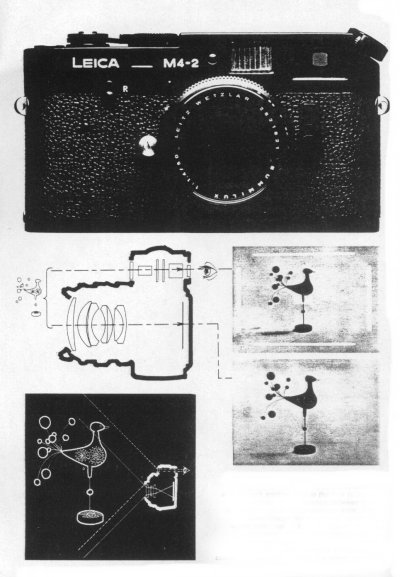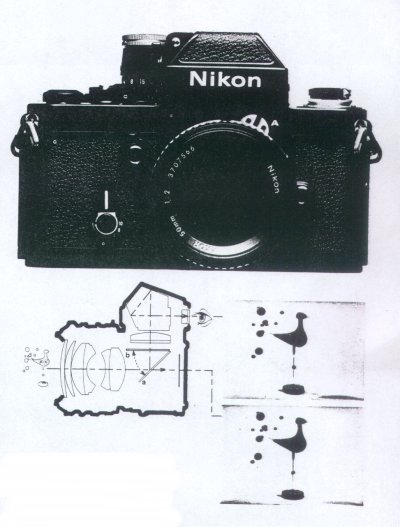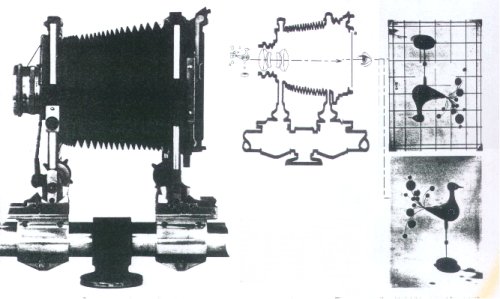
"The Four Major Types of Cameras"
1: Viewfinder
There are hundreds of different models of cameras, but all of them can be classified under four main
types according to the viewing system they use. Of the four, the smallest and the simplest to
operate are the viewfinder and small single-lens reflex cameras. They are basically eye-level
cameras; you put them up to your eye and use them as a direct extension of your vision into the
scene in front of you, making quick, candid pictures relatively easy to take.
The viewfinder in a viewfinder camera is a small peephole, usually equipped with a simple lens
system that gives you an image approximating what the picture will be. In cameras with fully
adjustable focusing, like the one shown, the viewfinder frames the subject more precisely and is
linked to the lens by a device called a coupled rangefinder so that the user can tell when his
picture is in focus.
Advantages of the viewfinder:
In its cruder forms it is inexpensive and has no moving parts to break down. In the more
sophisticated rangefinder models it provides excellent focusing, particularly at low light levels
where some other viewing systems do not function as well.
Disadvantages:
A simple viewfinder suffers from an inherent defect called parallax error (left) that prevents it
from seeing exactly what the lens sees. Unless parallax error is automatically compensated for
(as it is in high-quality cameras like the one shown here), it makes the viewfinder camera almost
useless for carefully composed closeup work, such as portraits or pictures of flowers. Also, images
that are seen through this type of viewfinder may be inconveniently small.
In viewfinder cameras light from the subject goes through the viewfinder to the eye
and through another ions to the film (cutaway, centre). The difference between these
two viewpoints is called parallax error. Thus, even though the viewfinder covers the
whole bird (broken lines in diagram at left), the lens does not (solid lines) and the
bird's head will be cut off in the picture. Better viewfinder cameras automatically
correct for parallax to match the views (above).
2: Single-lens Reflex
Obviously, the best way to see what the camera sees is to look right through the camera lens itself.
This way you can frame the subject precisely and tell how much every part of the scene, from
foreground objects to distant backgrounds, will be sharp or out of focus -something that cannot be
done with the viewfinder, whose lens produces a sharp image of everything it sees.
The single-lens reflex camera can do this. With a mirror and prism (diagram, right) it enables the
photographer to use the camera lens for composing and focusing pictures.
Advantages of the single-lens reflex:
It eliminates parallax. It is easily and quickly focused, which makes it good 'or candid photography.
Since the viewing system uses the camera lens itself, it obviously works equally well with all
lenses-whatever the lens sees, the photographer sees, unlike the viewfinder camera, which cannot
vary :he focusing scene to suit the picture taking lens.
Disadvantages:
The single-lens reflex is heavier and less compact than the viewfinder. It is also more complex and
hence more liable to break down. Because it has a moving mirror, it is noisy; it makes a loud click
when a picture is taken, compared to the almost inaudible click of a good viewfinder camera.
If you are stalking wild animals or selfonscious people, this is a drawback. And because of the path
the light travels to get to the user's eye-through lenses, off a mirror, then through a viewing
screen and a prism-finding the critical point of focus under poor lighting conditions is often
difficult. In this respect the viewfinder with rangefinder focusing is distinctly superior.
The key to the single-lens reflex camera is a mirror (a). Light coming in through the camera tens
is reflected upward by this mirror to a viewing screen, then through a five-sided prism that turns
the inverted image right-side up and right-side round and delivers it to the eye. When a picture is
taken, the mirror snaps up momentarily to position (b), permitting light to strike the film at the
back of the camera. Through-the-lens viewing produces an image virtually identical with that
produced on the film (bird pictures at right).
3: Twin-lens Reflex
Many photographers prefer that the image they see be projected onto a flat surface rather than seen
from eye level. In this way the photographer can turn a three-dimensional scene into a
two-dimensional picture, something that he can study and compose carefully.
The twin-lens reflex camera does this. Like the single-lens reflex camera, it also uses a mirror
that reflects an image of the scene upward onto a viewing screen. But its mirror is fixed, which
means that there must be one lens for the camera and a second one for viewing. These are coupled
mechanically, so that when one is in focus, the other is also.
Advantages of the twin-lens reflex:
The fixed mirror means simple, rugged construction and quiet operation, and the viewing screen
permits convenient accurate composition. Because the photographer looks into this camera from the
top, he can lower it to waist level or even place it on the ground an awkward angle for an eye-level
viewfinder, for photographing babies or pets.
Disadvantages:
The principal problem is parallax error, although the best twin-lens reflexes have automatic
parallax correction. Another drawback is that the image projected on the viewing screen is reversed
left to right, which takes some getting used to. The larger size of the twinlens reflex, while
permitting larger film, does make the camera somewhat more cumbersome for candid work. On many
twin-lens reflexes, lenses are not interchangeable.
The twin-lens reflex, like the viewfinder camera, has separate viewing and picture-taking systems.
Here they are stacked one over the other. The lower lens conducts light to the film. The upper one,
coupled to the lower for focusing, conducts light to a mirror (a) set at a 45º angle, whence it
is reflected upward to a viewing screen (b). Like all mirror reflections, the image appears reversed
left to right, as shown by the top photo. The top photo also shows a grid of hairlines etched on the
viewing screen to help compose the picture more accurately.
4: View Cameras
Can one get the benefits of throughthelens viewing and a large, picturelike image on a glass viewing
screen -all in one camera? Indeed one can. In fact that is the oldest and most direct kind of
viewing system that exists. The modern cameras that use this system, called view cameras, are
generally built like an accordion, with a lens at the front and a viewing screen at the back.
Focusing is achieved by moving the tens end forward or back until a sharp image is seen on the
viewing screen.
Advantages of the view camera:
The image on the viewing screen is projected directly there by the picture-taking lens, so what the
photographer sees is exactly what will be on his negative; there can be no parallax error.
Furthermore, the viewing screen is very large, permitting detailed examination by magnifying glass
to check sharpness of focus in all parts of the picture. The film size is also large, giving sharp
detail in large pictures. The camera itself is adjustable, permitting the photographer to tilt and
twist it to correct focus problems or distortion.
Disadvantages:
The most serious is the bulkiness of the camera; you must use a tripod. Second most serious is that
the image projected on the viewing screen is not very bright, and the photographer, to see it
better, must put a cloth over his head and the back of the camera. Finally, the image appears
reversed and upside down on the viewing screen. Photographers get used to this, but it is
disconcerting at first.
In the view camera, the light comes directly from the subject, through the lens, and falls on a
viewing screen (a) at the back of the camera; since the image that the photographer sees comes
directly from the lens, it is reversed and upside down, as the upper of the two bird photos shows.
Otherwise it is identical to what will appear on the film (lower photo). As an aid in composing
pictures, the viewing screen of this camera is etched with a square grid of hairlines.
* * * * * * * * * * * * * * * * * * * * * * * * * * * * * * * * * * * * * * * *
The Internet links provided on any of my pages to other sites are provided as a matter of
convenience, and I don't necessarily endorse what you may find there.





